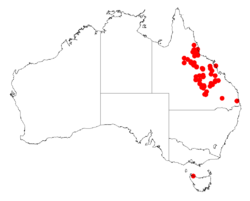Biology:Acacia dietrichiana
| Dietrich wattle | |
|---|---|
| Sketch of A. dietrichina from Iconography of Australian species of Acacia and cognate genera | |
| Scientific classification | |
| Kingdom: | Plantae |
| Clade: | Tracheophytes |
| Clade: | Angiosperms |
| Clade: | Eudicots |
| Clade: | Rosids |
| Order: | Fabales |
| Family: | Fabaceae |
| Subfamily: | Caesalpinioideae |
| Clade: | Mimosoid clade |
| Genus: | Acacia |
| Species: | A. dietrichiana
|
| Binomial name | |
| Acacia dietrichiana F.Muell.
| |

| |
| Occurrence data from AVH | |
Acacia dietrichiana, commonly known as Dietrich wattle,[1] is a shrub belonging to the genus Acacia and the subgenus Phyllodineae that is endemic to Queensland.
Description
The sparingly branched tree can grow to a height of 6 m (20 ft)[1] and has reddish coloured sticky branchlets.[2] It has dull blue-green oblong shaped[1] phyllodes that are straight and leathery, blunt and smooth with a length of 1 to 2.5 cm (0.39 to 0.98 in) and a width of 0.2 to 0.3 mm (0.0079 to 0.0118 in) with a prominent mid vein.[2] When it blooms between June and July[2] it produces golden spherical flower-heads followed by brown seed pods.[1] The bead like seed pods are straight and smooth with a length of 4 to 6 cm (1.6 to 2.4 in) and a width of around 5 mm (0.20 in).[2]
Taxonomy
The species was first formally described by the botanist Ferdinand von Mueller in 1882 as a part of the work Definitions of some new Australian plants as published in the journal Southern Science Record. It was reclassified as Racosperma dietrichianum by Leslie Pedley in 1987 then returned to the genus Acacia in 2001. The only other synonym is Acacia juncifolia var. planifolia.[3]
Distribution
The tree is found in inland areas of northern and central Queensland from the White Mountains in the north down to around Tambo in the south where it grows in rocky and shallow sandy soils.[2]
See also
References
- ↑ 1.0 1.1 1.2 1.3 "Dietrich Wattle". tree-guide.com. http://www.tree-guide.com/dietrich-wattle.
- ↑ 2.0 2.1 2.2 2.3 2.4 "Acacia dietrichiana Mimosasaceae". Native Plants Queensland. 2009. http://npqtownsville.org.au/Acacia-dietrichiana.html.
- ↑ "Acacia dietrichiana F.Muell.". Atlas of Living Australia. Global Biodiversity Information Facility. https://bie.ala.org.au/species/http://id.biodiversity.org.au/node/apni/2917264#names.
Wikidata ☰ Q15289534 entry
 |

